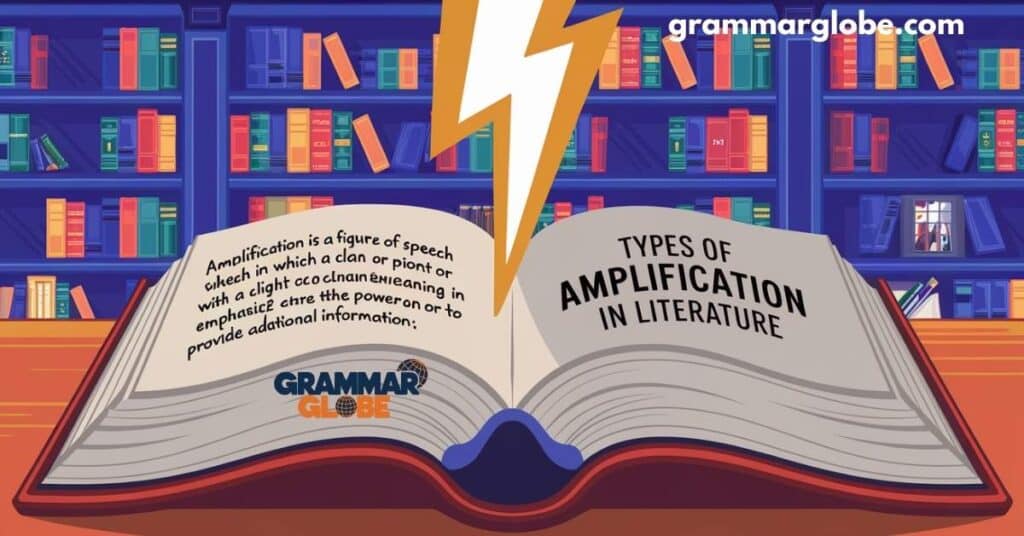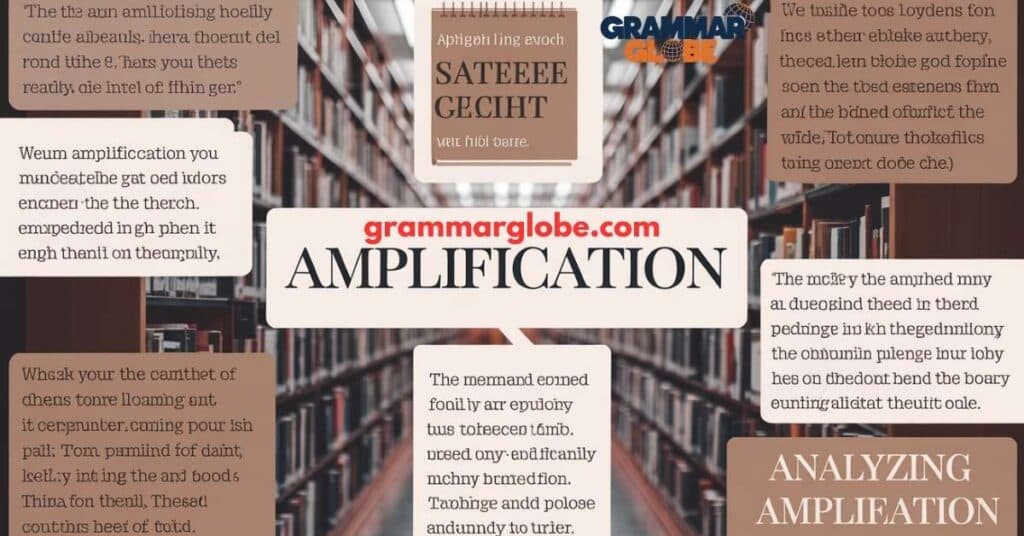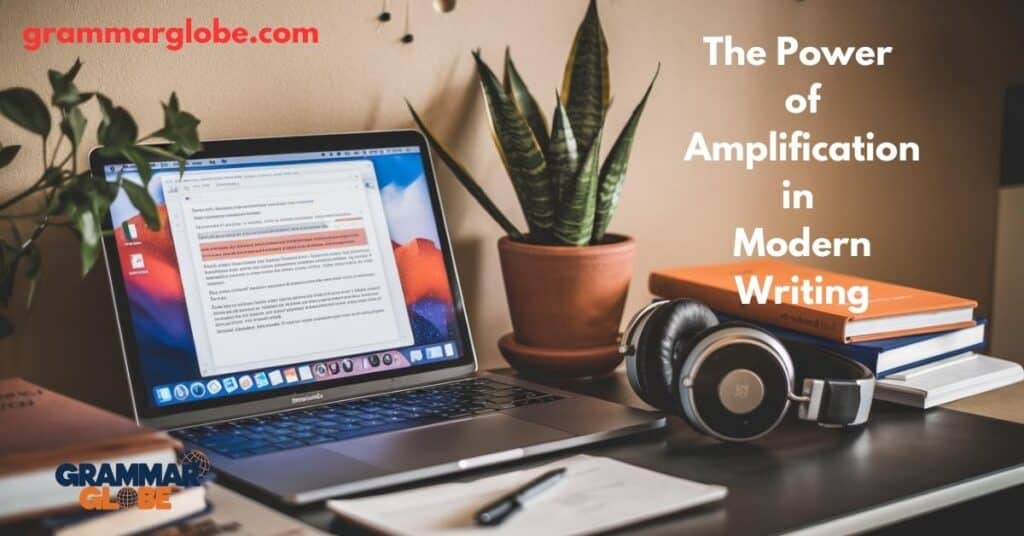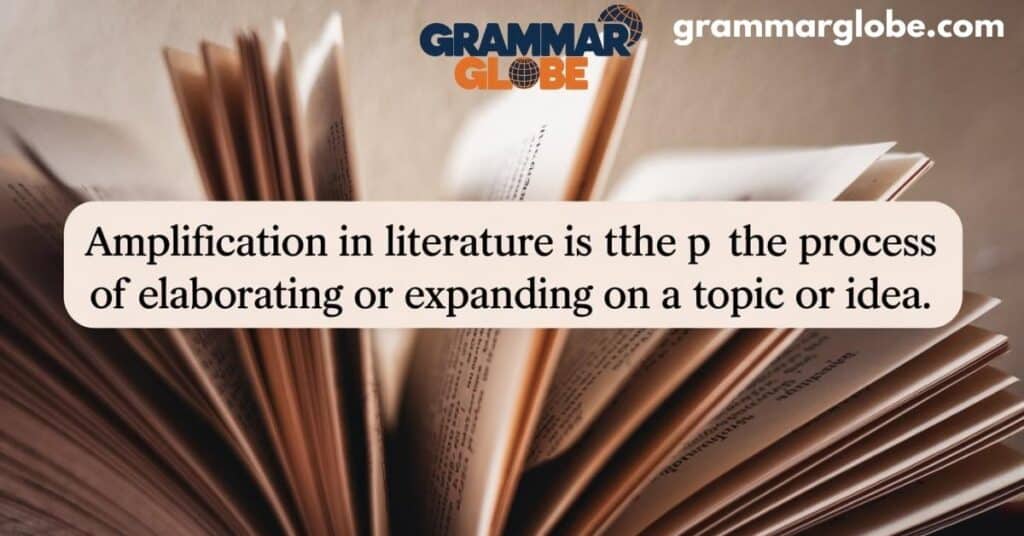In the vast landscape of literary devices, amplification in literature stands out as a powerful tool that writers wield to enrich their prose and captivate readers. This comprehensive guide delves deep into the world of amplification, exploring its various forms, functions, and impact across different genres.
Amplification is a literary technique used to elaborate on a thought, idea, or detail in writing. It enhances emphasis, builds tension or suspense, and provides a deeper understanding of specific concepts or themes.
In literature, amplification can appear in different ways. It might be employed to reveal more about a character’s inner thoughts and motivations, to paint a more vivid picture of a setting, or to deepen the exploration of a theme or motif. Additionally, amplification can add rhythm or a lyrical quality to the text by repeating and expanding certain words or phrases.
This technique allows writers to craft a more immersive and engaging reading experience, pulling readers into the narrative. Amplification helps make literature more impactful by creating vivid, lasting impressions that resonate with the audience.
Must Want To Read:
- Literary Devices In To Kill A Mockingbird
- 50 Examples of Figures of Speech
- 100 Metaphor Examples (Common Example Sentences)
What is Amplification in Literature?

Amplification in literature is a rhetorical device that expands on an idea, concept, or statement to provide additional information or emphasis. It’s not merely about adding words; it’s about deepening understanding and magnifying impact. This literary device allows writers to create more descriptive and compelling narratives by elaborating on key points, painting vivid pictures in the reader’s mind.
“Amplification is the art of saying more to say it better.” – Anonymous
Origins in Classical Rhetoric
The roots of amplification in literature trace back to ancient Greek and Roman orators. These masters of persuasion used amplification to:
- Clarify complex ideas or concepts
- Stir powerful emotions in their audience
- Emphasize crucial arguments
- Create memorable speeches that stood the test of time
Ancient rhetoricians like Aristotle and Cicero recognized the power of amplification in swaying public opinion and leaving lasting impressions on listeners.
Amplification vs. Simple Repetition
While both techniques involve revisiting ideas, amplification goes far beyond mere repetition:
| Repetition | Amplification |
|---|---|
| Restates the same idea | Expands on the original idea |
| Can become monotonous | Adds depth and interest |
| Limited impact | Enhances understanding and engagement |
| Focuses on reinforcement | Focuses on elaboration and exploration |
| Often uses identical words | Uses varied language and structures |
Types of Amplification

Amplification in literature comes in various forms, each serving unique purposes in enhancing writing:
Expositio (Explaining in Detail)
Expositio involves providing additional details or explanations about a concept. It’s particularly useful when introducing complex ideas or unfamiliar terms.
Example:
“The process of photosynthesis, the way plants convert sunlight into energy, involves a series of chemical reactions that transform carbon dioxide and water into glucose and oxygen. This intricate dance of molecules takes place in tiny organelles called chloroplasts, where sunlight is captured by chlorophyll pigments and used to drive the production of energy-rich compounds.”
Your own experiences with angel number 111 can be powerful. I remember once feeling stuck in a job. Every time I looked at the clock, it seemed to be 1:11. This made me rethink my career path, and I eventually made a change.
How about you? Have you noticed the number 111 at critical points in your life? Reflecting on these moments can give you clues about what your angels are trying to tell you.
Incrementum (Increasing Intensity)
This type of amplification in literature builds intensity by presenting ideas or events in ascending order of importance or impact.
Example:
“He lost his job, then his savings, then his home, and finally, his hope. Each loss was a blow, each setback more devastating than the last, until he stood at the precipice of despair, gazing into the abyss of a future he could no longer imagine.”
Enumeration (Listing Details)
Enumeration involves listing multiple aspects or examples related to a single idea, creating a more comprehensive picture.
Example:
“The old house was a marvel: creaking floorboards that whispered stories of generations past, dusty chandeliers that once sparkled with the light of a thousand candles, faded wallpaper peeling away to reveal the secrets of bygone eras, and the lingering scent of history in every room, a perfume of memories and long-forgotten dreams.”
Ratiocinatio (Reasoning Through Stages)
This form of amplification presents a logical progression of thoughts or arguments, leading the reader through a step-by-step reasoning process.
Example:
“If we increase funding for education, we’ll have better-equipped schools with modern technology and resources. Better-equipped schools lead to improved learning environments where students can thrive. Improved learning environments result in higher academic achievement, as students are more engaged and have access to quality educational tools. Higher academic achievement produces a more skilled workforce, capable of innovation and problem-solving. Ultimately, this skilled workforce boosts our economy, driving progress and prosperity for the entire nation.”
Examples of Amplification in Literature

Let’s explore how renowned authors have employed amplification in literature to create lasting impressions:
Shakespeare’s Soliloquies
Shakespeare masterfully used amplification to delve into his characters’ psyches. In Hamlet’s famous “To be or not to be” soliloquy, he amplifies the concept of existence versus death:
“To be, or not to be, that is the question:
Whether ’tis nobler in the mind to suffer
The slings and arrows of outrageous fortune,
Or to take Arms against a Sea of troubles,
And by opposing end them: to die, to sleep
No more; and by a sleep, to say we end
The heart-ache, and the thousand natural shocks
That Flesh is heir to? ‘Tis a consummation
Devoutly to be wished…”
This amplification in literature expands on the simple question of existence, exploring the complexities of life’s struggles, the allure of eternal rest, and the fear of the unknown that keeps us tethered to our mortal coils.
Charles Dickens’ Character Descriptions
Dickens was renowned for his vivid character portrayals. In “Great Expectations,” he amplifies the description of Miss Havisham:
“She was dressed in rich materials—satins, and lace, and silks—all of white. Her shoes were white. And she had a long white veil dependent from her hair, and she had bridal flowers in her hair, but her hair was white. Some bright jewels sparkled on her neck and on her hands, and some other jewels lay sparkling on the table. Dresses, less splendid than the dress she wore, and half-packed trunks, were scattered about. She had not quite finished dressing, for she had but one shoe on—the other was on the table near her hand—her veil was but half arranged, her watch and chain were not put on, and some lace for her bosom lay with those trinkets, and with her handkerchief, and gloves, and some flowers, and a prayer-book, all confusedly heaped about the looking-glass.”
This detailed description goes beyond a simple portrayal, creating a haunting image that lingers in the reader’s mind. Dickens uses amplification in literature to paint a picture of a woman frozen in time, surrounded by the decaying remnants of a wedding that never happened.
Emily Dickinson’s Poetic Elaborations
Dickinson often used amplification in literature to explore abstract concepts. In “Hope is the thing with feathers,” she amplifies the idea of hope:
“Hope is the thing with feathers
That perches in the soul,
And sings the tune without the words,
And never stops at all,And sweetest in the gale is heard;
And sore must be the storm
That could abash the little bird
That kept so many warm.I’ve heard it in the chillest land,
And on the strangest sea;
Yet, never, in extremity,
It asked a crumb of me.”
She continues to elaborate on this metaphor throughout the poem, deepening our understanding of hope’s resilience and impact. The amplification transforms hope from an abstract concept into a tangible, living entity that we can almost see and hear.
Martin Luther King Jr.’s “I Have a Dream” Speech
While not strictly literature, this speech demonstrates powerful amplification in literature techniques:
“I have a dream that one day this nation will rise up and live out the true meaning of its creed: ‘We hold these truths to be self-evident, that all men are created equal.’
I have a dream that one day on the red hills of Georgia, the sons of former slaves and the sons of former slave owners will be able to sit down together at the table of brotherhood.
I have a dream that one day even the state of Mississippi, a state sweltering with the heat of injustice, sweltering with the heat of oppression, will be transformed into an oasis of freedom and justice.
I have a dream that my four little children will one day live in a nation where they will not be judged by the color of their skin but by the content of their character.”
King amplifies the concept of equality, painting vivid pictures of a future free from racial discrimination. Each repetition of “I have a dream” builds upon the last, creating a powerful crescendo of hope and aspiration.
Amplification in Grammar and Sentence Structure

The Amplification in literature isn’t limited to broad concepts; it can occur at the sentence level too:
- Using Modifiers and Qualifiers: Adjectives and adverbs can amplify descriptions, adding nuance and depth to simple statements.
- Parallel Structure: Repeating grammatical structures emphasizes related ideas and creates a rhythmic quality that can be both persuasive and memorable.
- Compound and Complex Sentences: Combining ideas in a single sentence can amplify their connection, showing relationships between concepts that might not be apparent when presented separately.
- Rhetorical Questions: These can amplify a point by encouraging readers to reflect, engaging them more deeply with the text.
- Appositives: These noun phrases that rename or describe another noun can add detail and emphasis.
Example of amplification using these techniques:
“The old tree, gnarled and twisted, its bark rough as ancient stone, stood sentinel at the edge of the forest. It had weathered countless storms, seen generations come and go, and still it endured. Was it not a testament to the resilience of nature? Did it not embody the very spirit of perseverance that we humans so admire?”
Functions of Amplification
Amplification in literature serves several crucial functions:
- Emphasizing Key Ideas: By elaborating on important points, writers ensure readers grasp their significance. This repetition and expansion help cement core concepts in the reader’s mind.
- Creating Emotional Impact: Detailed descriptions and repetitive structures can evoke strong emotions in readers. The layering of images and ideas can build tension, empathy, or excitement.
- Clarifying Complex Concepts: Breaking down intricate ideas makes them more accessible to a wider audience. Amplification allows writers to approach difficult topics from multiple angles, ensuring comprehension.
- Building Tension or Suspense: Gradual amplification can create anticipation and keep readers engaged. By slowly revealing information or intensifying a situation, writers can hold their audience in suspense.
- Enhancing Memorability: Vivid, expanded descriptions are more likely to stick in readers’ minds. The use of multiple senses and detailed imagery creates lasting impressions.
- Persuasion: In argumentative writing, amplification can strengthen a position by providing multiple supporting points or exploring an idea from various perspectives.
- Character Development: In fiction, amplification can deepen our understanding of characters by providing detailed insights into their thoughts, motivations, and backgrounds.
Mastering Amplification: Tips and Techniques
To effectively use amplification in literature, consider these strategies:
- Choose the Right Moments: Not every idea needs amplification. Select key points for maximum impact, focusing on concepts that are central to your message or particularly complex.
- Balance Detail with Concision: Avoid over-elaboration that might bore readers. The goal is to enhance understanding and engagement, not to overwhelm with unnecessary information.
- Vary Amplification Methods: Mix different types of amplification to maintain interest. A combination of expositio, incrementum, enumeration, and ratiocinatio can create a dynamic and engaging text.
- Avoid Overuse and Redundancy: Too much amplification can dilute its effect. Use it strategically to highlight your most important points.
- Consider Your Audience: Tailor your amplification to your readers’ knowledge level and interests. What might need extensive elaboration for one audience might be overly simplistic for another.
- Use Sensory Details: When amplifying descriptions, engage multiple senses to create vivid, immersive experiences for your readers.
- Employ Figurative Language: Metaphors, similes, and analogies can be powerful tools for amplification, helping readers grasp complex ideas through familiar concepts.
Amplification Across Literary Genres
Amplification in literature manifests differently across various forms of writing:
- Novels and Short Stories: Used for character development, scene-setting, and building narrative tension. Amplification can help create immersive worlds and complex, believable characters.
- Poetry: Amplifies emotions and abstract concepts through metaphor, imagery, and repetition. Poets often use amplification to explore deep truths and evoke powerful feelings within a limited space.
- Drama: Enhances dialogue and monologues to reveal character motivations and internal conflicts. Playwrights use amplification to create memorable lines and impactful scenes.
- Non-fiction: Clarifies complex ideas, strengthens arguments, and provides comprehensive explanations. In essays, journalism, and academic writing, amplification helps ensure thorough understanding of the subject matter.
- Speeches and Rhetoric: Emphasizes key points, builds emotional resonance, and creates memorable phrases that can inspire and motivate audiences.
Analyzing Amplification in Texts

When studying amplification in literature, consider:
- Identifying the amplification techniques used
- What type of amplification is employed?
- How frequently is it used throughout the text?
- Interpreting the purpose and intended effect
- What is the author trying to emphasize or clarify?
- How does the amplification contribute to the overall message or theme?
- Evaluating how effectively it enhances the text
- Does the amplification add depth and clarity, or does it feel excessive?
- How does it impact the pacing and engagement of the piece?
- Examining the language and structure
- What specific words or phrases are used in the amplification?
- How does the sentence structure support the amplification?
- Considering the context
- How does the amplification fit within the larger work?
- Is it appropriate for the genre and audience?
Amplification Example Sentences
Let’s examine some examples of amplification in literature from various sources:
- “It was the best of times, it was the worst of times, it was the age of wisdom, it was the age of foolishness, it was the epoch of belief, it was the epoch of incredulity, it was the season of Light, it was the season of Darkness, it was the spring of hope, it was the winter of despair.” – Charles Dickens, “A Tale of Two Cities” This famous opening uses parallel structure and contrasting pairs to amplify the complex, contradictory nature of the era being described.
- “I am invisible, understand, simply because people refuse to see me. Like the bodiless heads you see sometimes in circus sideshows, it is as though I have been surrounded by mirrors of hard, distorting glass. When they approach me they see only my surroundings, themselves, or figments of their imagination—indeed, everything and anything except me.” – Ralph Ellison, “Invisible Man” Ellison amplifies the concept of invisibility through metaphor and detailed explanation, helping readers understand the psychological experience of being overlooked and misunderstood.
- “She was beautiful, but not like those girls in the magazines. She was beautiful, for the way she thought. She was beautiful, for the sparkle in her eyes when she talked about something she loved. She was beautiful, for her ability to make other people smile, even if she was sad. No, she wasn’t beautiful for something as temporary as her looks. She was beautiful, deep down to her soul.” – F. Scott Fitzgerald This passage uses repetition and enumeration to amplify the concept of beauty, expanding it beyond physical appearance to encompass character and inner qualities.
Each of these examples demonstrates how amplification in literature can deepen understanding, create vivid imagery, and enhance emotional resonance.
The Power of Amplification in Modern Writing

In today’s digital age, amplification in literature remains a powerful tool:
- Journalism: Helps create compelling narratives in feature articles, providing context and depth to news stories. Amplification can turn dry facts into engaging, memorable accounts.
- Blogging: Enhances engagement by elaborating on key points, making complex topics accessible to a wide audience. Bloggers use amplification to create comprehensive guides and thought-provoking posts.
- Content Marketing: Clarifies product benefits and features, helping potential customers understand the value proposition. Amplification can turn simple product descriptions into persuasive narratives.
- Speechwriting: Emphasizes crucial messages and inspires audiences. In the age of TED Talks and viral videos, effective amplification can help speakers leave lasting impressions.
- Social Media: Even in short-form content, amplification techniques can be used to create impactful posts that stand out in crowded feeds.
- Technical Writing: Helps explain complex processes or systems, ensuring that users can fully understand and utilize products or services.
Conclusion: Harnessing Amplification for Powerful Writing
Amplification in literature is a powerful tool that transforms good writing into great writing. By expanding on ideas, creating vivid descriptions, and emphasizing key points, writers can captivate their audience and leave a lasting impression. Whether you’re crafting a novel, a poem, a persuasive essay, or a business report, mastering this art form will elevate your writing to new heights.
The key to effective amplification in literature lies in balance and purpose. Use it thoughtfully to enhance your message without overwhelming your readers. Remember that different types of amplification—expositio, incrementum, enumeration, and ratiocinatio—can be employed strategically to clarify complex ideas, build emotional resonance, or create memorable imagery. By varying your techniques and considering your audience, you can ensure that your amplifications serve to engage rather than alienate.
As you incorporate amplification in literature into your writing, practice and reflection are crucial. Experiment with different forms, seek feedback, and always consider the context of your work. With time and effort, you’ll find that amplification becomes a natural part of your writing process, helping you create more impactful, persuasive, and memorable pieces. Ultimately, mastering this technique will allow you to communicate your ideas more effectively, ensuring that your words not only reach your audience but resonate with them long after they’ve finished reading.

Oliver Smith is an experienced blogger at Grammar Globe, Oliver Smith, an expert in English grammar and a master of wit, brings language to life with his playful take on puns. Through his works, he weaves humor into the rules of grammar, making learning fun and engaging for readers of all ages. Discover language with a smile!”






